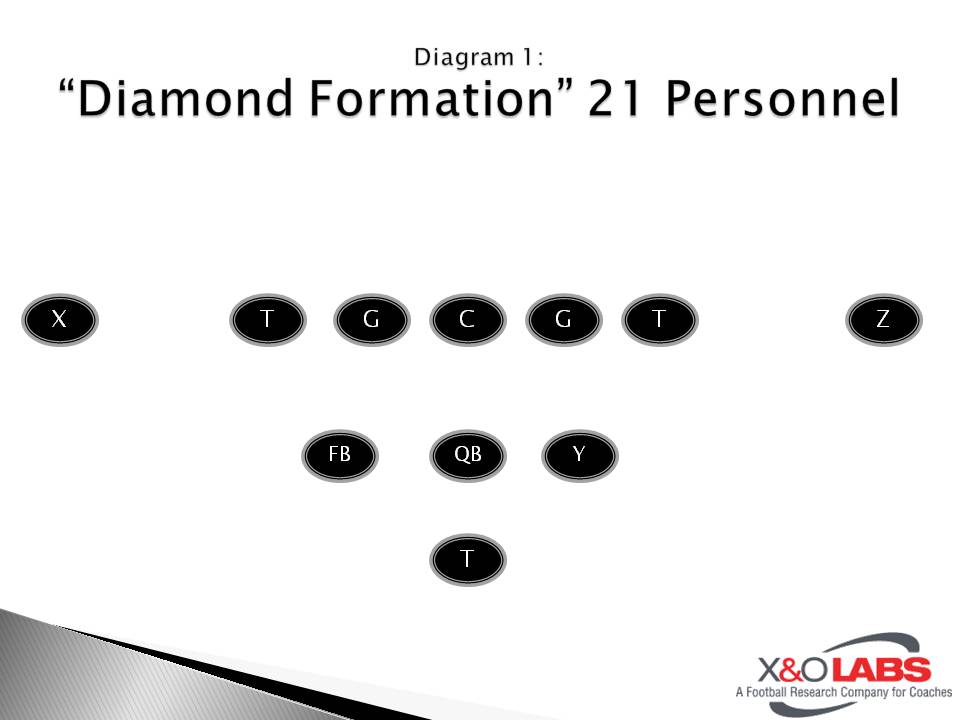By Mike Kuchar
Senior Research Manager
X&O Labs
Researchers' Note: You can access the raw data - in the form of graphs - from our research on the Diamond Formation: Click here to read the Statistical Analysis Report.
You’ve seen both the Pittsburgh Steelers and Green Bay Packers showcase it in front of millions of people in last year’s Super Bowl. Then you saw Bob Stoops at Oklahomatoy with it in Norman. Finally you saw former Oklahoma State offensive coordinator Dana Holgorsen bring it to a whole other level and dice defenses in Stillwater. It was "score at will" time for the Cowboys, propelling Holgorsen to his first head coaching job - now he’s doing it at West Virginia. So, chances are by now, you are familiar with at least the structure of the diamond formation (Diagram 1), but have you had the gaul to use it? If you’re like most of the coaches we spoke with, you’re still hesitating on dipping both feet in.
In fact, when we distributed our survey on the diamond formation to over 10,000 coaches we asked that only those that use the diamond formation respond…356 hit us back. Now we realize that it is clinic season, but that number should be a good indicator of how many coaches still have not incorporated the diamond formation into their offense. What’s more is that of those 356 coaches, 57.3 percent of them use it in less than 10 percent of their offensive schemes. Probably the most telling facet of our research was that of all of the coaches that use the formation said they will use more of it next season. If that’s not a testament to its value, we don’t know what is. But again, we’ll try to be unbiased in producing the following research - even if our coaches can’t.
When asked why they’ve decided to utilize the diamond formation, we got a laundry list of benefits. These are in no particular order.
Benefits of Using the Diamond Formation:
- Mismatches on the Perimeter: With nine players in the backfield (five offensive lineman and four backs) defenses are sure to load the box by playing 8-man fronts or locking down the perimeter. Once the defense loads the box, you get one-on-one coverage with the outside receivers. The pass game is a report all to itself, one that we will follow up with in the next couple of weeks.
- Extra Hats = Extra Gaps: Whether you specialize in man, zone or gap run schemes, the extra blocker coming from the backfield is a big bonus. You can run inside zone and still have a lead blocker (by having the backside back cut off the C gap). You can run Power and have the backside back pull and lead through or you can simply run your isolation schemes and send both backs through the point of attack (as Urban Meyer did with Tebow a few years back). It’s a terrific equalizer to teams that will try to put eight or nine defenders in the box - you have eight to block them.
- Three-Back Offensive Sets: This is why even the old-school Wing T guys love this set. You get the opportunity to have three of your better athletes on the field at one time and really develop your run game concepts by distributing the football.
- Balances Up the Defense: You force defenses to declare their strength pre-snap by setting their front and their coverage. Once they tip their hand, you can run Power or Isolation either way (with the QB checking which side). A balanced offense makes it difficult for an even front defense to set its strength and it allows teams to audible and run at the 1-tech or 3-technique. You can run the same plays both directions without shifts/motions.
- Instant Misdirection: We all know how difficult it is for defenses (particularly at the high school level) to diagnose misdirection schemes efficiently. The three-back set up in the diamond formation provides you with misdirection on any run scheme, because chances are you need only two backs at the point of attack - you can send the other one away. Gap schemes tend to work best because you don’t need to pull an offensive lineman. Many of the coaches we spoke with also believe that it eliminates defender’s ability to cross read vs. schemes like the inside zone and allows offenses to effectively run the inverted veer with the QB play side.
- Pre-Snap Motions and Shifts: Once you start in the diamond formation and defenses declare, it’s similar to empty where you can move and motion to get the numbers advantage you want. They can’t overload the box because now they’re forced to expand a defender out of the core. We devote and entire case study below on some of the most common pre-snap movements our coaches have used.
Get Our Upcoming Research Report Revealing Pass Game Strategies in the Diamond Formation. Enter Your Email Address in the Email Sign Up Box in the Right Hand Margin of This Page >>>>>> Above Our Facebook Fan Box. It’s FREE!
Case 1: Alignments and Personnel
We’ve found that when using the Diamond Formation, 49.4 percent of coaches will mainly run out of this set 75 percent of the time. While there are several opportunities to throw the ball, there is no question it is a run-first formation with lethal play-action possibilities off corresponding run actions. In the survey, we inquired about personnel and which is more suitable for running this formation. We’ve seen both: we’ve seen the Oklahoma State’s of the world run it out of 10 or spread personnel while professional teams like the Carolina Panthers used more 21 personnel with the addition of an H-Back. When our survey concluded, we noticed that 42.5 percent use 21 personnel while 37.3 percent use 10 personnel - these were the two personnel groupings of choice based on our coaches.
Tom McPherson, the head coach at Ridgeview High School (FL) uses both 30 and 10 personnel groupings in his diamond formation. When he’s in 30 personnel, he’ll have three viable backs (two sniffers and one tailback) to run his power and kick run game as well as his isolation run game. He’ll cheat his sniffers up to two yards from the line of scrimmage so they can get to the point of attack quicker. "We’re a no tight end team, so we have a hard time handling seven in the box," said McPherson. "Now we can kick and wrap our sniffers and have seven blockers in the box. Our traditional diamond set is the only three back set where I use 10 personnel. I think in terms of bigger backs or smaller backs. Changing personnel helps with practice planning because I’m not going to do any jet sweep meshes with the big backs, only with the smaller skill kids in 10 personnel. I won’t ask a big back to be the jet sweep guy. He will only be the power guy."









